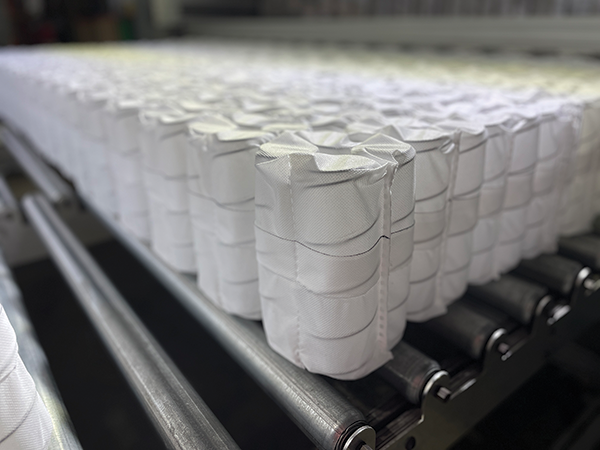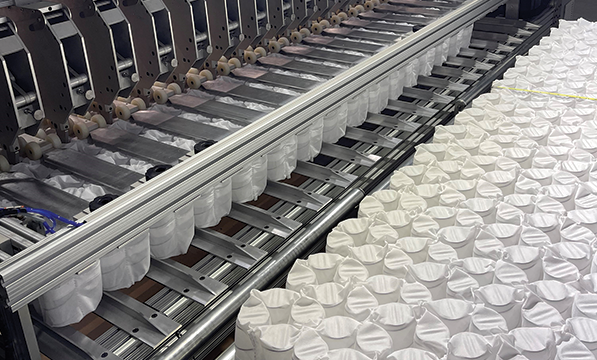Working from a variety of angles, suppliers, recyclers and others are making it easier to recycle one of a mattress’ most challenging components — the pocketed coil unit.
Pocketed spring units are making their way into more and more mattresses for good reason: Many consumers appreciate the good night’s sleep that the springs provide.
And bedding manufacturers like to tout their benefits: They reduce motion transfer and “trampolining” better than open coil designs, are quieter and conform well to a sleeper’s body, springs makers say. They’re also durable, holding their shape and height over years of nightly use.
There’s just one downside. It’s a perhaps unexpected but important one: When a mattress has reached the end of its useful life, recyclers have had a difficult time dismantling the pocketed coil unit inside. In fact, some recyclers say, disassembling pocketed coil units is more challenging than dismantling any other item they’ve encountered — across industries and product categories.
And that has meant that too many units have been ending up in landfills — big and bulky, taking up valuable space.
The situation has been even more frustrating to recyclers because the primary components of most units — steel coils and nonwoven polypropylene fabric — can be among the most lucrative mattress materials to sell in commodities markets. By sending pocketed spring units to landfills, they’ve been throwing
money away.
But in recent years, the mattress industry — from recyclers to machinery producers to bedding component suppliers to the Mattress Recycling Council — has been addressing the problem from all angles, keeping more units from landfills and creating a more sustainable supply chain. (The International Sleep Products Association created the MRC in 2014 as a nonprofit organization to implement state recycling laws.)
“The mattress industry does a wonderful job designing and making innovative products that help consumers enjoy a restful, safe and affordable night’s sleep,” says Ryan Trainer, president of both the ISPA and MRC. “As consumers, regulators and industry focus increasingly on our products’ environmental impact, mattress manufacturers and component suppliers are also using their innovative talents to develop creative solutions to today’s recycling challenges. I am excited to see different players in the mattress value chain collaborate to design diverse technologies, materials and equipment that will help recyclers dismantle pocketed springs more efficiently.”
In this case study, we’ll give you an overview of the challenges pocketed springs present to recyclers and the industry’s wide-ranging efforts to mitigate those. Then we’ll delve into the advancements in machinery, spring units, glues and mattress constructions that will keep more pocketed springs out of landfills and give new life to their components.
“On the surface, this is the story of one mattress component,” Trainer says. “But if you look deeper, it’s the tale of how the bedding industry is working together to create a more sustainable world.”
The growing scope of the challenge
A 2022 MRC analysis of the stream of mattresses and foundations entering recycling facilities in California found that 28% of all units included pocketed coils, says Mike O’Donnell, chief operating officer of MRC, which operates mattress recycling programs in California, Connecticut, Rhode Island and, starting later this year, Oregon, too.


Michelle Williams is president of Mat Recyclers in Rancho Cucamonga, California, which specializes in mattress recycling. She estimates the percentage of pocketed spring units arriving at her facility to be closer to 20% but the number is steadily increasing.
“I was just talking to my plant manager about it, because it’s something we talk about daily now,” Williams says. “He’s seen (the percentage) double just in four or five years.”
Remember: Mattresses entering the recycling stream now were made years ago. Another recent MRC research project determined the average age of a discarded mattress today is 13.9 years.
How much more of the used mattress stream could contain pocketed springs in the years to come?
“From the manufacturers that we’ve spoken to, about 60% of their volume is pocketed coils. So, we’re expecting the number of units we’re getting to grow significantly,” says Mike Gurnee, CEO of Xtraction Inc. in Fresno, California, and Tough Stuff Recycling in Fitchburg, Massachusetts.
Breaking them down
So clearly, recyclers need effective ways to deal with pocketed springs. But why is it so hard to recycle them, especially when they’re typically made up of just two main components: steel coils and spun-bond polypropylene fabric, along with a bit of glue to hold everything together?
“The problem is the disassembly process,” Williams says. “There is no efficient way to do it manually. It’s incredibly time intensive to cut up the fabric pockets and pull the fabric away (from the steel).”
“If we had 10 (units) a day, I could have someone sit in a corner and take a box cutter to them, but we’re trying to be super efficient,” she continues. Her facility currently receives about 200 pocketed spring units a day. “We’re not a nonprofit,” she says. “We’re concerned about revenue and costs and finding a way to sell the components as commodities or finding ways to upcycle them.”
Until more recently, even mechanical dismantling methods have struggled to neatly separate the steel coils from the fabric to create the clean streams of materials that commodities markets value most. Also bothersome to recyclers: The strength and shape of the steel coils can damage dismantling machinery, quickly dulling blades and getting tangled in machinery parts. But there have been big improvements in machinery.
Eric Buck has long been frustrated by pocketed spring units. His company, Customized Recycling Programs in Florence, Kentucky, has recycled countless tons of waste from a wide variety of companies across industries.
It’s not a one-and-done deal. We need to be thinking, ‘What’s the next version we can do? What’s the next step and the next step?’
“We recycle several different commodities that have been historically deemed unrecyclable, but pocketed coil springs have proven to be the most difficult material by far,” Buck says. Yet he had an incentive to figure out an effective, efficient way to do it because, he says, “the commodities, after they are separated, are the easiest things to sell. Everybody wants the steel and polypropylene.”
Buck and two partners set out to create an automated solution and now offer a dismantling and separation system through a separate company, Pocket Coil Recycling.
Thanks to advancements in dismantling machinery, Williams now sends Mat Recycles’ pocketed units to another, larger recycler in California for disassembly. “So, they are recycled, just not by us,” she says. “In the long term, our ultimate goal is to find some sort of an automated, machine-based solution to process pocketed coils ourselves. That way we’ll no longer rely on another recycler and will be able to sell the excess metal (and fabric) to help support our revenue.”
Read more about other innovations in dismantling machinery from Atlanta Attachment Co. and others here.
A less significant problem, but another that the industry is addressing, is the glue used to affix fabric pockets. It can make it more difficult to disassemble mattresses and can reduce the quality of the nonwoven polypropylene. For a time, the contamination wasn’t much of a problem because recyclers could find markets for fabric with glue residue, but that changed, O’Donnell says, when China banned most plastic waste imports in 2018. A report from National Public Radio says that by 2016, China was importing 7 million tons of plastic waste a year. In 2019, it took in just 1% of that total, according to NPR. With the China market essentially gone, recyclers are more particular about the purity and quality of components.
To keep the polypropylene fabric unsullied, springs makers are now offering glueless units that are welded ultrasonically or with resistance heating instead. And adhesives suppliers are formulating polypropylene glues. Leggett & Platt Inc. is rethinking the entire construction of hybrid mattresses, making all the key components, including comfort foam layers and coil units, easier to separate and recycle.
The years to come

The industrywide approach to recycling pocketed coil units can provide a guide for bedding manufacturers, suppliers and recyclers as they strive to make all their processes and products more environmentally sustainable.
At the second ISPA Sustainability Conference, held last September in Charlotte, North Carolina, O’Donnell says, “there was a robust conversation happening between both mattress manufacturers and recyclers to discuss, not only pocketed coils but every layer of the mattress and every mattress component, to create a better understanding of how component and design choices are made and how they affect the recyclability of the product at end of life.”
Those forward-looking conversations are essential to fostering sustainability across the industry.
“I think the last two (ISPA) Sustainability Conferences have really pushed (product end of life) to the forefront, and some of these R&D teams are really starting to think that way,” says Doug Guffey, chair of the MRC board and vice president of sales for Hickory Springs Manufacturing’s bedding division in Hickory, North Carolina. “And it’s not a one-and-done deal. We need to be thinking, ‘What’s the next version we can do? What’s the next step and the next step?’ ”




